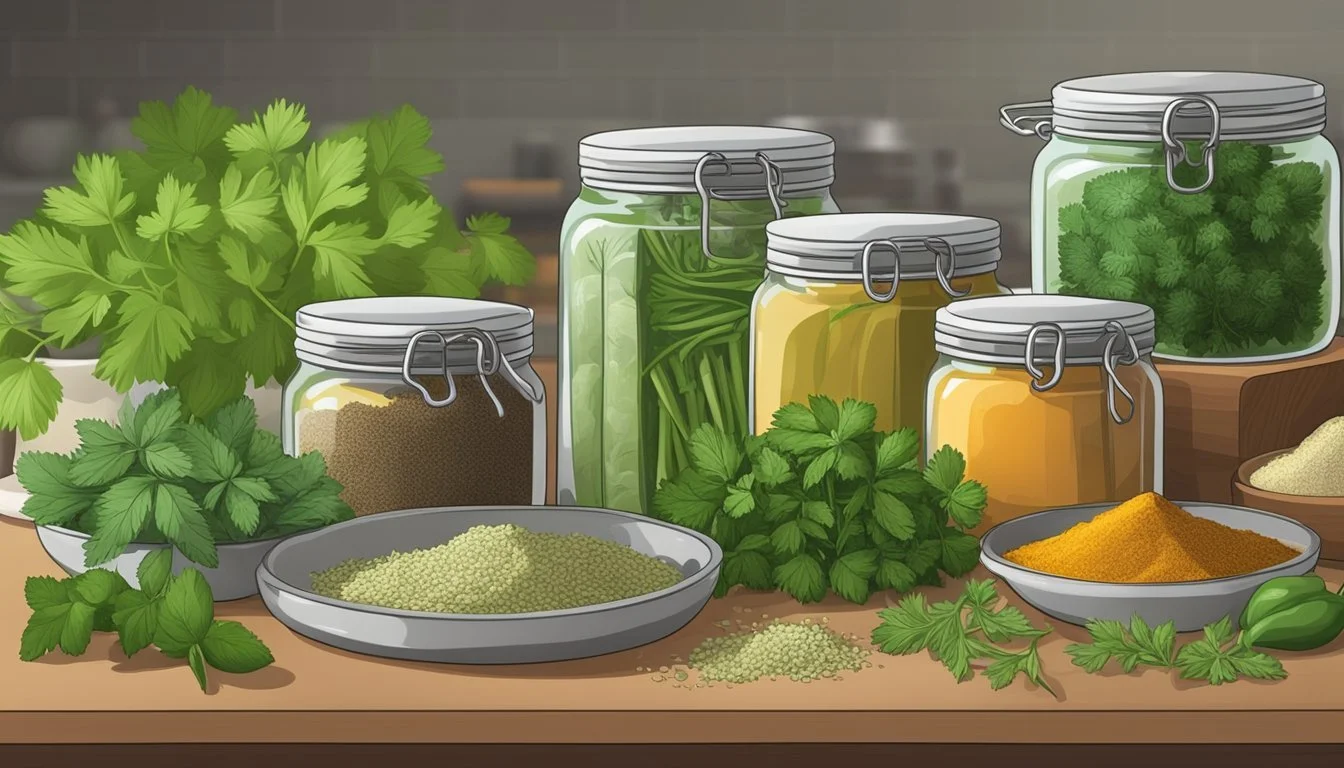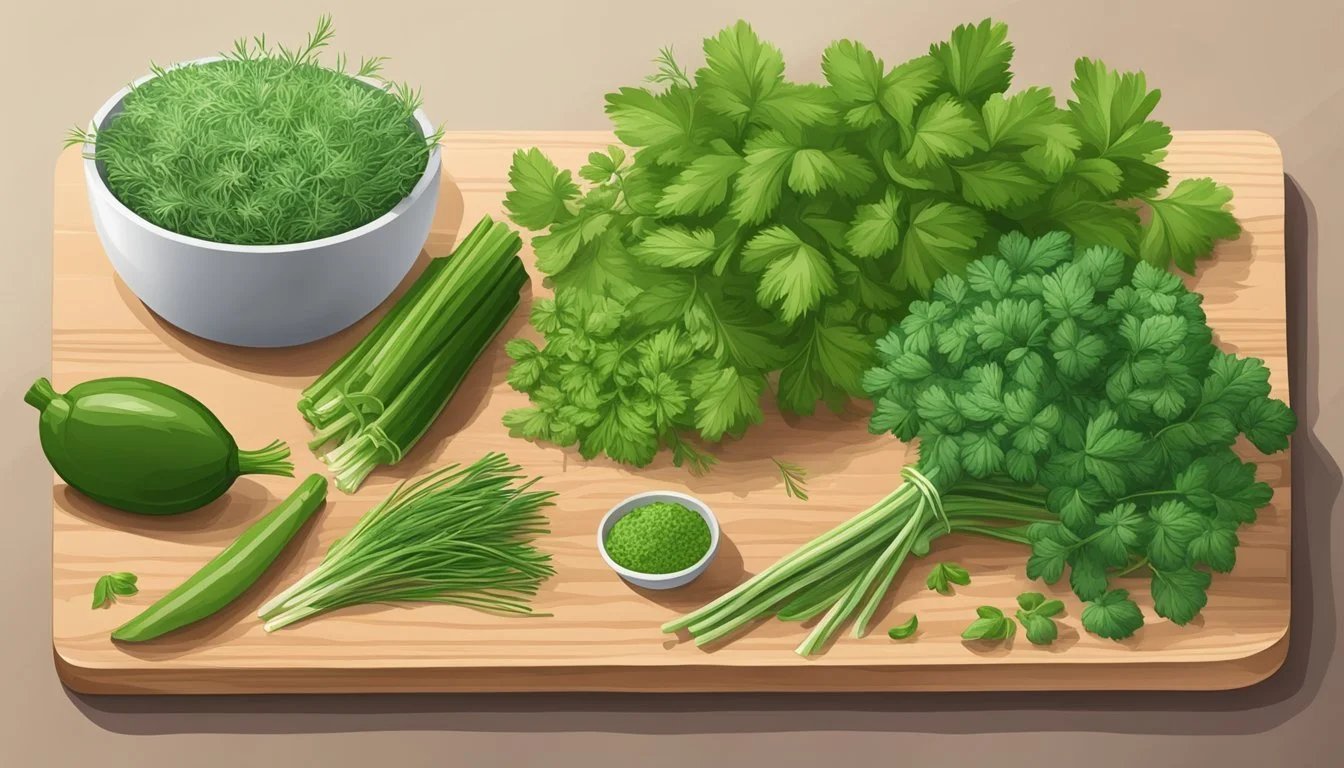Parsley Substitutes
Top Alternatives for Your Recipes
Parsley is a ubiquitous herb in kitchens around the globe, prized for its vibrant taste and fresh, decorative appeal in numerous dishes. However, there are instances when parsley is not at hand, prompting the need for suitable alternatives. Parsley substitutes come in handy not only when the herb is unavailable but also for those who may prefer different flavors or have parsley allergies. Substitutes can include other fresh herbs, dried herbs, or even non-herbal ingredients, each bringing its unique profile to a dish while providing a similar aesthetic role as parsley.
Choosing the right parsley substitute depends largely on the particular recipe and the role parsley plays within it. When fresh parsley is called for, options such as cilantro, chervil, or celery leaves can provide a similar green and fresh note. For recipes requiring dried parsley, one may consider dried chervil or dried cilantro, keeping in mind the potency difference between dried and fresh herbs. In dishes where parsley's bright color is desired, carrot greens or arugula might serve as excellent replacements, both offering a green hue and contributing a distinctive taste.
Understanding the flavor profile and texture of parsley is crucial in selecting an appropriate alternative. While some substitutes may closely match the flavor of parsley, others may add a slightly different taste, bringing a new dimension to a recipe. The key is to balance the substitute's flavor with the other ingredients and the desired outcome of the final dish. With the right substitute, the absence of parsley can still result in a dish that is both visually appealing and delicious.
Understanding Parsley
Before exploring parsley substitutes, it is essential to understand its varieties, health benefits, culinary uses, and difference between its fresh and dried forms, as well as its role in various world cuisines.
Parsley Varieties
Parsley, a commonly used herb, comes in several varieties, each with distinct characteristics. Curly leaf parsley, often used as a garnish, has ruffled leaves and a mild flavor. Flat-leaf parsley, or Italian parsley, is favored for its more robust flavor and is widely used in cooking. Less common is root parsley, also known as French or Hamburg parsley, which is grown for its edible root.
Health Benefits of Parsley
Parsley is packed with antioxidants, vitamins, and minerals. It's high in vitamin K, essential for bone health, and is a good iron source. Parsley's vitamin A content, from beta carotene, supports eye health, and its vitamin C boosts the immune system. Some studies suggest parsley may help in blood sugar control, making it beneficial for overall health.
Parsley In Cooking
In cooking, parsley is not just a garnish but a versatile flavor enhancer. It's incorporated into a plethora of dishes, including soups, stews, sauces, salads, and stocks. It complements fish dishes, meatballs, and is integral to tabbouleh, a Middle Eastern salad.
Fresh vs Dried Parsley
Fresh parsley provides a bright, peppery taste to dishes, while dried parsley offers a more subdued flavor. The latter is more suitable for longer cooking processes where its flavor can infuse over time. Typically, less dried parsley is needed than fresh due to the concentrated flavor.
Parsley in World Cuisines
Parsley plays a significant role in Mediterranean cuisine and Middle Eastern cuisine. It is not only a flavoring agent but also a key component in many traditional dishes, underlining its global culinary importance.
Common Parsley Substitutes
When fresh or dried parsley is unavailable, several herbs can offer similar qualities to dishes. The following substitutes can provide comparable flavors and are often readily accessible.
Cilantro as a Substitute
Cilantro, with its bright and citrusy flavor profile, serves as an excellent stand-in for parsley. Particularly useful in Mexican, Asian, and Indian cooking, fresh cilantro can enhance salsas and salads with its distinct zest.
Basil, The Aromatic Alternative
Basil offers a sweet and slightly peppery taste, making it a suitable parsley alternative in Italian recipes. Both fresh and dried basil work well in pesto and tomato-based dishes, with sweet basil being the most common variety and Thai basil providing a more robust anise-like flavor.
Green and Leafy: Celery Leaves
The often-overlooked celery leaves can mirror parsley's appearance in dishes. These leaves provide a subtle, grassy flavor, acting as a flavor enhancer in soups, salads, and stews.
Chervil, The French Choice
Chervil's delicate flavor is similar to parsley while having anise undertones, and it's a staple in the famous French fines herbes blend. Fresh chervil is preferable, but dried chervil can also suffice, especially in light French sauces and poultry dishes.
Tarragon's Distinct Flavor
With its bittersweet taste and a hint of vanilla, tarragon offers a unique alternative to parsley. It's commonly found in French recipes and pairs exceptionally well with chicken dishes, bringing a level of complexity to the cuisine.
Oregano, The Mediterranean Staple
Oregano is more robust than parsley but can be used as a substitute in a pinch, particularly in Italian and Greek recipes. Both fresh and dried oregano contribute a bold, earthy flavor to a variety of savory dishes.
Unique Parsley Substitutes
When traditional parsley is not available, there are a variety of other herbs and leafy greens that can provide a unique twist to dishes. Each substitute brings its own distinct flavor profile and can enhance the dish differently than parsley.
Bold and Bitter: Arugula
Arugula, with its bold and peppery taste, is an excellent parsley substitute in Italian salads and can add a unique edge as a pizza topping. Its strong flavor is especially suited to fresh applications rather than cooked dishes.
The Mild Option: Carrot Greens
Carrot tops, the green leafy parts of carrots, are often discarded but can be a mild and slightly sweet stand-in for parsley. They work well in root vegetable recipes and can add depth when chopped into soups.
Nutty and Peppery: Endive
Endive contributes a nutty and mildly peppery flavor, making it a good addition to both salads and stuffed dishes. Its crisp texture can be particularly refreshing when used as a garnish.
Mint: A Fresh Touch
Mint can provide a cool and refreshing flavor that is ideal for a twist on the traditional. It's excellent in Greek recipes, paired with lamb dishes, or used to give a fresh touch to mojitos.
Alternative Garnishes to Parsley
When parsley isn't available or someone desires a different flavor or texture profile, there are several viable alternatives. Each substitute brings its own aesthetic appeal and flavor characteristics that can enhance a dish just as effectively as parsley.
Chives, The Delicate Garnish
Fresh chives offer a subtle onion-like flavor that complements a variety of dishes without overpowering them. They work particularly well sprinkled over potato dishes and blended into sour cream for a classic garnish. Dried chives can also be used, but remember that their flavor is more concentrated, so a smaller amount may suffice.
Curly Endive for Texture
Curly endive provides a frilly texture that stands out, especially in salads. Its slightly bitter taste can add depth to dishes, making it an excellent parsley substitute both visually and flavor-wise. Its robust form holds up well as a garnish when added just before serving.
Dandelion Greens' Earthy Flavor
Dandelion greens have a distinct, earthy flavor and can add a nutritional boost as an alternative garnish. They work best in salads and sautés where their bitterness can be counterbalanced by other flavors in the dish. One should use the tender young leaves to avoid an overly bitter taste.
Scallions for a Bright Finish
Green onions, or scallions, have a milder flavor than most onions and bring a bright, crisp finish to noodle dishes and stir-fries. As an alternative for parsley, the green part can be finely chopped and sprinkled over the dish just like a parsley garnish, adding color as well as a gentle bite.
Culinary Tips for Using Substitutes
When cooking with substitutes for parsley, it is vital to understand how flavor profiles interact and the importance of choosing the right substitute to complement the dish. The key is to maintain balance without overwhelming the intended flavors of the recipe.
Balancing Flavors
Incorporating alternative herbs requires a delicate balance. When swapping in cilantro or chervil, they use a 1:1 ratio as both offer a freshness akin to parsley. Cilantro adds a lemony-peppery flavor, suitable for vibrant dishes, while chervil introduces a mild taste, often favored in fines herbes blends. For more potent dried herbs, they typically suggest less—approximately 1 teaspoon of dried herb for every 1 tablespoon of fresh parsley.
Selecting Substitutes Based on Dish
The type of dish guides the selection of the appropriate substitute. For example, in rice dishes or casseroles, milder herbs like celery leaves may suffice, but for beans or veggies, a bolder alternative like oregano could enhance the flavor profile without dominating it.
Herbs Pairing
They prioritize freshness and complementary flavors when pairing herbs. While substituting for parsley in recipes that call for fines herbes, use chervil or tarragon for their aromatic qualities. For garnishes, opt for herbs that resemble parsley's appearance, such as cilantro or finely chopped carrot tops, which also bring distinct flavors to the dish.
Preservation and Storage of Herbs
Proper preservation maintains an herb's flavor and freshness. Store fresh herbs like parsley wrapped in a damp paper towel inside a refrigerator to extend their lifespan. For dried herbs, ensure that they are kept in a cool, dark place in airtight containers to preserve potency.
Health Considerations When Choosing Substitutes
When selecting parsley substitutes, one must consider dietary restrictions, nutritional profiles, and potential impacts on digestion to ensure that the alternative aligns with health goals and needs.
Dietary Restrictions and Allergies
People with dietary restrictions or allergies should scrutinize parsley substitutes with caution. Allergies to herbs are not common, but they can occur. For instance, someone allergic to mugwort may also react to herbs like chervil, which belongs to the same family. In terms of dietary preferences, ingredients like carrot greens may be more suitable for those seeking plant-based options, due to their versatility in vegan and vegetarian dishes (What wine goes well with vegetarian dishes?).
Nutritional Value Comparison
Parsley is known for its rich content of vitamin K and fiber, so substitutes should preferably offer similar nutritional benefits. When comparing the nutritional value, it's important to note the following:
Chervil contains lower levels of vitamin K but can still be a decent source for individuals monitoring their intake.
Carrot Greens provide dietary fiber which is beneficial for digestion and overall intestinal health.
Substitute Vitamin K Content Fiber Content Chervil Lower Moderate Carrot Greens Moderate High
Impact on Digestion
Introducing new herbs as substitutes may have varying effects on an individual’s digestive system. Fiber from substitutes like carrot greens supports digestion, but the change in fiber source should be gradual to prevent digestive discomfort. Substitutes with high fiber content are beneficial to the gut, but one must ensure they are well-tolerated to avoid gastrointestinal issues. Select alternatives that maintain a balance and do not disrupt the digestive process.




